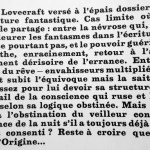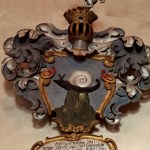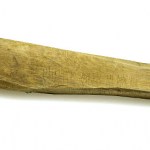language
I was pleased to learn from Current Archaeology #330 (p. 65) that Chris Catling shares my distaste for the habit scientists have recently picked up of prefixing their answers to interview questions with ”So...”.
Q: Where did you find the new exciting fossil?
A: So we found it in Mongolia.
Q: How old is it?
A: So it's from the Early Cretaceous.
What annoys me about this isn't just that it's new. I know that us speakers change language over time. My irritation is down to the fact that I reserve ”So”, when used in this position in a phrase, for two other purposes. Either to mean ”thus, ergo, it…
You all know about this: It is being said that the OK sign is used to indicated "White Power" and this use has been spotted among politicians and celebrities everywhere. Is this real? I don't know. Is it a valid symbol for "White Power"? Certainly not.
The problem with the white power symbol is that it is not a symbol. Or, if it is a symbol, it is a baby symbol that doesn't know how to be a symbol yet, so don't expect much from it.
Semiotics Ahead Index (not an icon, not a symbol, but yes, it is a sign. With a sign on it.)
Try this.
Move your hands in front of you as though you were…
It is a good idea to occassionally experience history. This helps us understand ourselves, and our possible futures, better. Much of this is done through reading excellent texts. For example, I'm currently reading Team of Rivals: The Political Genius of Abraham Lincoln by Doris Kearns Goodwin. Goodwin's objective is to contextualize Lincoln by looking at him in the broader context of the individuals that ran against him for the Republican nomination, and whom he later added to his cabinet. Goodwin succeeds, at several points, in placing the reader in a time or place of great import.…
... or any other human language for that matter. Even though both monkeys and humans have the anatomical tools for speech, only humans communicate in this manner. Researchers had assumed, incorrectly, that the anatomy of the vocal tract (lips, tongue, larynx) of monkeys was not capable of producing speech. A new study published in Science Advances shows instead that it is all in our heads.
The researchers came to this conclusion after creating x-ray videos of macaques making sounds and eating. They used these videos to create computer models that could translate the…
Have you ever wondered how "Dick" became short for "Rick"?
Probably not. But it turns out that the reason, if the following video is accurate, is interesting.
I have two questions for the historical linguists in the room. First, is there a name for this rhymification effect? Is is common? Is it confined to certain regions or cultures? Is it linked to Cockney in some way?
OK, that was a lot of questions, but really, all the same question. My second one is simpler: Where does the phrase "Swinging dick" come in? It is a Britishism for, I think, Square Mile money managers and investors.…
1972 back-cover blurb
I bought a used copy of Maurice Lévy's Lovecraft ou du fantastique (Paris 1972) at the Fantastika 2016 scifi con, and now I'm picking my way through it with the aid of a dictionary. S.T. Joshi has published an English translation, Lovecraft: A Study in the Fantastic (Detroit 1988).
Here's how little of Lévy's literary French I understand without a dictionary. This back-cover blurb is a particularly hairy piece of writing, I should say.
The case of Lovecraft … the thick volume of fantastic literature. A limited case where … should cease: between a neurosis which, while…
I visited Grödinge church south of Stockholm for the first time Thursday. The occasion was my great aunt Märta's funeral, an event which, though of course sombre, cannot be called tragic. The old lady was always cheerful and friendly, but by the time she passed away she was 104, severely disabled, and according to her many descendants quite tired of it all. As I like to say, I don't fear death but I certainly don't want to become disabled or isolated in my old age. For most of her remarkably long life Märta was in fine shape, and she was never isolated at all.
Grödinge is one of Sweden's…
Research published last month in PNAS provides evidence that African elephants (Loxodonta africana) can differentiate human voices. This is a very important skill to an animal that is often threatened by humans. Prior research has shown that elephants could tell the difference between African ethnic groups using sight and scent.
The study was conducted by Drs. Karen McComb and Graeme Shannon (University of Sussex, Brighton, UK). They recorded men from two different Kenyan ethnic groups speaking in their native language the phrase "Look, look over there, a group of elephants is coming." The…
This is nice.
Karl Eccleston and Fiona Pepper are amazingly good actors. The writing is excellent as is the directing. The subtext. THE SUBTEXT IS BRILLIANT.
When I was living with the Efe Pygmies in the Ituri Forest, they would imitate French and English speakers while ranting about specific people who had annoyed or amused them. It was easy to tell which they were doing ... French vs. English. But it only sounded like people imitating people, it didn't sound like the real thing. I remember Sid Caesar doing this as part of his regular routine in several languages, and talking about…
We interrupt this transmission for a puerile message from Medieval Bergen. It was found carved with runes on a stick at the Hanseatic docks.
ion silkifuþ a mek en guþormr fuþcllæikir ræist mik en : ion fuþkula ræþr m(e)k (N B434)
“John Silkencunt owns me and Guttorm Cuntlicker carved me and John Cuntball reads me”
Philologists are not certain as to whether fuþkula, “cuntball”, means clitoris, or a well-padded mons veneris, or “cunt cavern”. All the three mentioned men are historical figures known from other sources, but apparently they are usually referred to there as John Silk, Guttorm…
I have a problem with the term Viking Age. And it's not likely that I will ever get satisfaction. Because I am a Scandy archaeologist, and the term is owned by UK historians and the general English-speaking public.
The three-ages system was established by C.J. Thomsen in his 1821 book Ledetraad. It divides Scandinavian Prehistory into three ages, characterised by the material used in cutting tools: first stone, then bronze, then iron. In Swedish, this taxonomical level is the ålder – stenåldern, bronsåldern, järnåldern – using the close cognate of what Snorri back in the 13th century called…
I found something pretty wild in an essay by J.L. Borges this morning. There's a 13th century Norse saga about the Buddha. And the story has other fine twists as well. This all revolves around a legendary tale of the Buddha's early life.
In the 6th century BC a son was born to a petty king in what is now Nepal. He was named Siddharta, and it was prophesied shortly after the boy's birth that he would become either a great king or a great holy man. His father then kept him carefully protected from contact with religion and human suffering, apparently to keep the boy away from the holy-man…
The Grey Mouser, along with Fafhrd the Northerner hero of Fritz Leiber's genre-defining sword & sorcery story cycle, is the archetype of the Dungeons & Dragons thief. He began his career however, Leiber informs us, as apprentice to a "hedge-wizard" who taught him some simple magical cantrips. I never understood what a hedge-wizard was, until now. I imagined it had to do with living in a squalid cottage out in the fields and being in touch with nature, druid-like.
Reading Avram Davidson's story "The King Across the Mountains", I now came across a hedge-parson. And googling, I found out…
My boss at the Academy of Letters used to head the National Archives. Here's a story he told over coffee the other day.
Some decades ago a delegation of Swedish archivists was driving across the American Midwest to visit a Mormon microfilming facility. Stopping in a small town for lunch, they noticed that it had an unusual name in a Native American language. At a fast food restaurant, the head of Stockholm's town archives asked the cashier,
"Excuse me miss, we're from Sweden and this place has such an unusual name. Could you please tell me how to pronounce it?"
The young lady stared at him…
Until a few minutes ago, I didn't even know what the heck Vocal Fry is. Apparently some people have gotten really annoyed about it, as it is a speech mannerism that has emerged among young folks, who are always annoying, and especially females, who are always annoying. Apparently. (I also did not know that until a few minutes ago! I'm learning a lot of new stuff today!)
It's been written up in a scientific journal (see below), in popular media, and it was brought to my attention by a facebook post of Debby Goddard's. But of all the sources I've seen, the following video best describes the…
"This one will look like a jellybean," the session director warns us. "Or, you know, when you empty a hole punch? The circles of paper that fall out? One of those." She's talking about Neptune, and I am about to step, carefully, up a ladder painted industrial yellow and wheeled into place in front of the centenarian eyepiece of the 60" Hale telescope at Mt. Wilson Observatory, incidentally the very place where Edwin Hubble, in 1925, discovered that our galaxy was not the entirety of the Universe, and later, that our Universe was expanding.
A jellybean, a piece of confetti: it seems her…
To scientists, "experimental" is a technical word, one with a precise meaning: that which relates to a procedure of methodical trial and error, to a systematic test for determining the nature of reality. I got in trouble on this blog once, with commenters, for using the word "experimental" too flippantly.
But artists experiment too, of course. Their method of inquiry is different, free from the rigidity that characterizes the scientific method. Artistic experiments are designed to be singular; they aren't supposed to be repeated. They have no control variables. Often, even the…
In order to find her easter egg, my daughter first had to solve a +1 transposition cryptogram with appended translation table. It gave her the location of a note with a +9 cryptogram where she was given the offset but had to write her own translation table. This led to a +9 cryptogram that resolved into Mandarin written with pinyin. She needed little help. Though since there were no tone indicators in the encrypted pinyin, she at first searched beneath a window (chuÄng) instead of under a bed (chuáng).
Dungeon: a massive inner tower in a Medieval castle or a dark usually underground prison or vault. Traceable back to Latin dominus, lord.
Dudgeon: a wood used especially for dagger hilts or a fit or state of indignation. Traceable back to Anglo-French digeon.
Gudgeon: a pivot or a small European freshwater fish (Gobio gobio, Sw. sandkrypare). Traceable back to Middle French goujon resp. Latin gobius.
Bludgeon: a short stick that usually has one thick or loaded end and is used as a weapon. Unknown origin, first known use 1730.
Thanks to Merriam-Webster.
When I was 16 in 1988 I spent a couple of days in Paris with a language school. I brought the address for a game store, one that advertised in White Dwarf magazine. It was on Rue Poirier de Narcay, which turned out not to be a central location, and so I never went there. But I've wondered off and on through the years about this funny street name, "The street of the pear tree of Narcay".
And now, of course, the net can cure any idle wonderings in an instant. Turns out, the street is named for a medical doctor, Robert Poirier de Narcay, whose dissertation De l'ascite congénitale was published…








